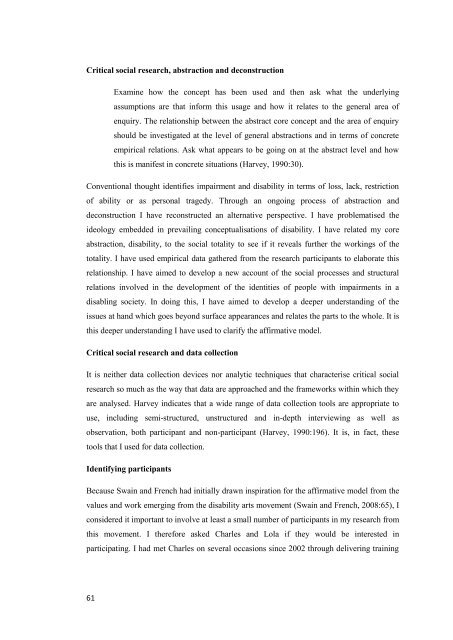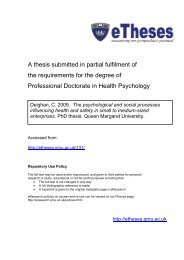A thesis submitted in partial fulfilment of - Etheses - Queen Margaret ...
A thesis submitted in partial fulfilment of - Etheses - Queen Margaret ...
A thesis submitted in partial fulfilment of - Etheses - Queen Margaret ...
Create successful ePaper yourself
Turn your PDF publications into a flip-book with our unique Google optimized e-Paper software.
Critical social research, abstraction and deconstruction<br />
61<br />
Exam<strong>in</strong>e how the concept has been used and then ask what the underly<strong>in</strong>g<br />
assumptions are that <strong>in</strong>form this usage and how it relates to the general area <strong>of</strong><br />
enquiry. The relationship between the abstract core concept and the area <strong>of</strong> enquiry<br />
should be <strong>in</strong>vestigated at the level <strong>of</strong> general abstractions and <strong>in</strong> terms <strong>of</strong> concrete<br />
empirical relations. Ask what appears to be go<strong>in</strong>g on at the abstract level and how<br />
this is manifest <strong>in</strong> concrete situations (Harvey, 1990:30).<br />
Conventional thought identifies impairment and disability <strong>in</strong> terms <strong>of</strong> loss, lack, restriction<br />
<strong>of</strong> ability or as personal tragedy. Through an ongo<strong>in</strong>g process <strong>of</strong> abstraction and<br />
deconstruction I have reconstructed an alternative perspective. I have problematised the<br />
ideology embedded <strong>in</strong> prevail<strong>in</strong>g conceptualisations <strong>of</strong> disability. I have related my core<br />
abstraction, disability, to the social totality to see if it reveals further the work<strong>in</strong>gs <strong>of</strong> the<br />
totality. I have used empirical data gathered from the research participants to elaborate this<br />
relationship. I have aimed to develop a new account <strong>of</strong> the social processes and structural<br />
relations <strong>in</strong>volved <strong>in</strong> the development <strong>of</strong> the identities <strong>of</strong> people with impairments <strong>in</strong> a<br />
disabl<strong>in</strong>g society. In do<strong>in</strong>g this, I have aimed to develop a deeper understand<strong>in</strong>g <strong>of</strong> the<br />
issues at hand which goes beyond surface appearances and relates the parts to the whole. It is<br />
this deeper understand<strong>in</strong>g I have used to clarify the affirmative model.<br />
Critical social research and data collection<br />
It is neither data collection devices nor analytic techniques that characterise critical social<br />
research so much as the way that data are approached and the frameworks with<strong>in</strong> which they<br />
are analysed. Harvey <strong>in</strong>dicates that a wide range <strong>of</strong> data collection tools are appropriate to<br />
use, <strong>in</strong>clud<strong>in</strong>g semi-structured, unstructured and <strong>in</strong>-depth <strong>in</strong>terview<strong>in</strong>g as well as<br />
observation, both participant and non-participant (Harvey, 1990:196). It is, <strong>in</strong> fact, these<br />
tools that I used for data collection.<br />
Identify<strong>in</strong>g participants<br />
Because Swa<strong>in</strong> and French had <strong>in</strong>itially drawn <strong>in</strong>spiration for the affirmative model from the<br />
values and work emerg<strong>in</strong>g from the disability arts movement (Swa<strong>in</strong> and French, 2008:65), I<br />
considered it important to <strong>in</strong>volve at least a small number <strong>of</strong> participants <strong>in</strong> my research from<br />
this movement. I therefore asked Charles and Lola if they would be <strong>in</strong>terested <strong>in</strong><br />
participat<strong>in</strong>g. I had met Charles on several occasions s<strong>in</strong>ce 2002 through deliver<strong>in</strong>g tra<strong>in</strong><strong>in</strong>g




